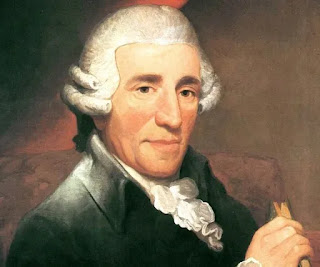Musical Analysis #1: Haydn's Sonata in F major
In this blog, I will be discussing the elements of the 3rd movement of Haydn's sonata in F major, Hob. XVI/23, link below.
Recording: https://www.youtube.com/watch?v=Ds79nmCS3-Q
Written in 1773 in Austria, this is the final of three movements in Haydn's sonata in F major, and the funniest one. This sonata starts out light hearted, moving to somewhat somber, and ends in a bit of a joke. In this movement, one can make out two voices throughout the piece going back and forth as if they are having a conversation. I have found it is somewhat common for composers to write their music to be a conversation, and this piece really brings it out. This piece is unique in that the whole conversation is basically the two voices going back and forth telling jokes! It is something I haven't heard yet in another piece, and Haydn used a variety of musical elements to bring out to make it a really funny piece.
The Melody
One highlight in the melody is that he shifts between major, minor, and major to tell the set up, a somber turn, and finally a punchline. Then, in the middle, he goes on a tangent modulating from key to key using broken chords until the melody returns to start the subject he started with, but doesn't complete the joke there! He just uses the first phrase to keep modulating until finally he ends that statement. Finally, after the recap of the beginning, he ends the piece on a cliff hanger and the audience is left at the edge of their seat, waiting for the punchline that will never come. The first time I heard the ending, I laughed almost an uncomfortable laugh because I didn't think it was even a thing in music to just end without a proper conclusion!
The Dynamics
From my experience, Haydn doesn't typically write a whole lot of dynamics, so many versions add some markings or it is left up to the player's interpretation. In the particular recording I have chosen, I particularly enjoy how pronounced the musician, Oleg Volkov, makes each change in dynamics. Somber, or repeated phrases are softer or louder to add to the feeling of statement and response that make up a conversation.
The Tempo
Finally, the tempo of this movement and Volkov's interpretation of it helps Haydn's musical jests to land just right. When played slowly, this piece takes on a more monotonous feel, and a listener might think "Can we just get to the point already?". Haydn writes that the tempo is Presto, or "very fast" in order to get a more light hearted and punchy feel. When playing fast, it is a balance to have speed without rushing and also give room for the listener to catch what is being said in the music. I particularly appreciate that Volkov captures this balance and also adds some rubato and pauses when appropriate to allow us to savor a line and anticipate the next. These pauses also make the ending that much more unexpected as you think the music is about to come back and say something, but instead it just leaves you hanging.
Some Background
Since Haydn wrote over 50 sonatas, over 100 symphonies and many other works, it is difficult to find out what may have been the reaction to the piece at the time, or really any commentary on it past or present. Therefore, I shall expound on Haydn's background and roughly the events for which this Sonata was written.
Haydn was essentially a founding father of the classical era in music. In his life, he was a highly successful musician and composer, teaching and influencing the likes of Beethoven and Mozart. His primary employment was in the court of the Esterházy family. There, he composed a pieces for his students as well as on demand for the duke whenever he had a gathering and wanted some background music or entertainment. Writing so often, he became known for experimentation and being a general, musical jokester; hence, this Sonata in F major Hob. XVI/23.
Citations
Biography.com Editors. "Franz Joseph Haydn Biography." Biography.com, A&E; Television Networks, Apr. 2, 2014. Updated Sept. 12, 2022. https://www.biography.com/musicians/franz-joseph-haydn
Zilberkant, Eduard. Personal interview. Sept. 13, 2023.
Farrant, Dan. "The Ten Basic Elements of Music." hellomusictheory.com. Updated Feb. 9, 2024. https://hellomusictheory.com/learn/elements-of-music/



I watched the youtube video before reading your blog post, and absolutely felt the humor in this piece! The pianist, Oleg Volkov is fun to watch. He is incredibly talented and seems to be having a fun time playing; especially towards the beginning of the piece, he seemed almost as if he were bouncing in his seat. Thank you for sharing this wonderful piece!
ReplyDelete